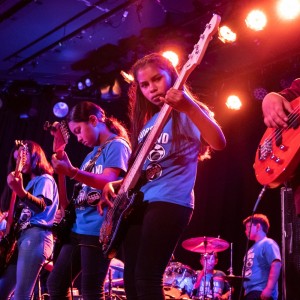It's Friday evening at Union Station in downtown Los Angeles, and, like always, commuters are catching trains to their bedroom communities and weekend travelers are jumping on the Pacific Surfliner.
And then there's a less harried crowd milling around the old wooden seats under the arches of the grand waiting room, headphones clamped down over their ears. They are told to respect those using the station, especially the homeless who take sanctuary there and the people running to trains.
A few hundred people are here to enjoy the opera Invisible Cities - through headphones - performed by 15 singers and dancers and an 11-piece orchestra throughout the station, even in the Mission-style courtyards.
It is billed as the first large-scale opera for wireless headphones and it may be coming to a train station near you. While the maiden run for "Invisible Cities" ended Sunday after 21 performances, the artists and technologists behind it say other cities like Bordeaux in France are keen to see wireless opera performed in their train stations.
Invisible Cities is based on the 1972 novel by Italian writer Italo Calvino, and its music and libretto is written by 29-year-old Christopher Cerrone of New York City. He and director Yuval Sharon, 34, began discussing it in 2008 and by 2012 had settled on an immersive, ambulatory and wireless format.
In Invisible Cities Venetian explorer Marco Polo soothes the troubled emperor Kublai Khan, who sees his empire as a "vast and formless ruin," with tales of travels to great cities.
"We decided that the piece, which is so intimate and so warm and so fragile, would best be suited being heard as if it is whispered in your ear," said Sharon, artistic director of the opera company The Industry.
"It is a story that is really meant to take you to a very internal place."
EXPLORING L.A. LIFE
Sharon moved to Los Angeles three years ago and was fascinated by Union Station, the last large-scale train station built in America and completed in 1939. He thought if they had the tools to let the audience wander freely, no other building would be better to explore the life of L.A., both its glories and its weaknesses.
"There is a beautiful line in the piece in which Marco Polo says, 'I will create a perfect city made of all the fragments of cities I have ever been to,'" Sharon said.
Martin Gimenez, lead sound designer, was inspired by the audio tours by docents in museums and the "silent discos" where people gather and listen to music by headphones. But scaling those ideas to a larger space with more people was a challenge.
Most of the technology was provided by audio manufacturer Sennheiser, maker not only of the headphones but also of the wireless system set up around the station so the audience experiences the music with clarity wherever it goes.
The wireless system works for the performers, too. The orchestra and conductor sit in a defunct restaurant while the company roams the station for the 70-minute performance, never getting a glimpse at the conductor.
Los Angeles Times music critic Mark Swed called Invisible Cities a "startlingly ambitious project" - one that "could be, and should be, done anywhere."
As the opera unfolds, Marco Polo sits at a restaurant table singing while three businessmen at the next table carry on with a conversation, oblivious to the fact that they are in the midst of performance. The words are projected on to the station wall.
Dancers convulse and contort on the floor of the waiting room, as homeless men and women and passengers nap, bedding and belongings tucked under their feet. Some in the audience share their headphones with people who don't have tickets.
At the end, the audience is encouraged to linger, enjoy a drink at the station bar with friends and discuss the experience. They may be at the leading edge of opera-going.
"I believe that opera is always at the forefront of what we are doing as artists," Cerrone said. "It's always been this forward-thinking art form, embracing new technologies, at least in the 19th century. It just seemed natural to try new things."
(Reporting by Mary Milliken, editing by Bill Trott)



